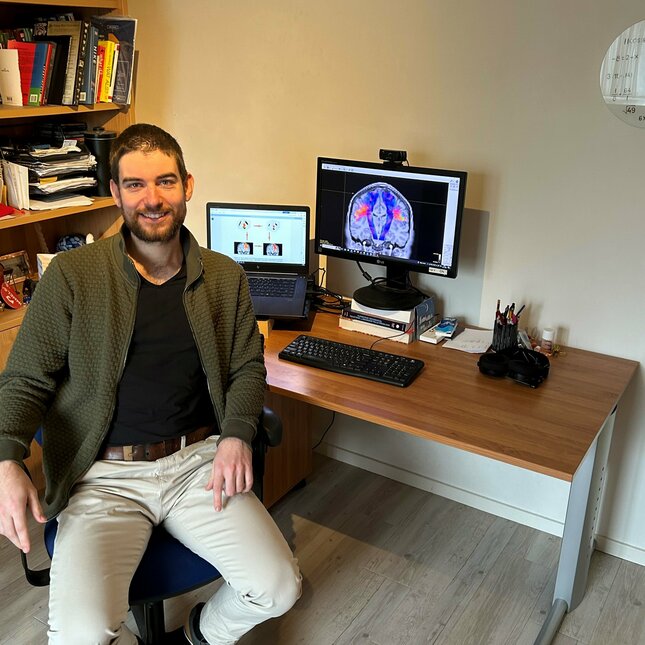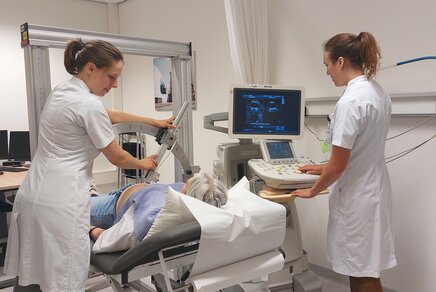Combining math and biology to provide a clearer image of brain tissue
Improving tractography methods enables neurosurgeons to provide more personalized care.

In highly complicated operations such as tumor resections, it is critical for neurosurgeons to know the location of both the tumor and nearby nerve bundles. To maximize the success rate of the operation, it is of the utmost importance to get the sharpest possible image of the brain beforehand. Currently, Diffusion Weighted Imaging (DWI) is often used for this purpose. However: DWI in fact only measures the mobility of water, and therefore only provides an indirect image of nearby nerve bundles. PhD student Rick Sengers focused his research on the improvement of tractography methods by determining the location of nerve fiber bundles, thereby achieving a clearer and completer image. He defended his thesis on January 23.
DWI: a powerful tool, but not yet complete
Diffusion Weighted Imaging (DWI) is a Magnetic Resonance Imaging (MRI) protocol, which allows for measurements of water diffusion patterns in the brain. It is a non-invasive technique. This allows a neurosurgeon to take a look inside the brain of a patient without surgical operations. Although this is already a giant step forward in neurosurgery, DWI has a disadvantage: because it focuses on measuring the mobility of water, this method provides only an indirect measurement of the desired nerve bundles. To make DWI's toolbox more complete, Senders focused his research precisely on determining the location of such nerve bundles. In doing so, Sengers applied a unique combination of mathematics and biology, improving existing tractography methods.

Research at the interface of biology and mathematics
One of the main premises in Sengers' research is that the structure in the white matter of the brain - the bundles of elongated axons that connect nerve cells in the gray matter - promotes movement in the direction of nerve fibers and hinders movement in the transverse directions. This principle causes a new 'distance measure' to be defined. The candidate nerve pathways are then 'short' if the average diffusivity along the pathway is large. Finding candidate nerve fibers is thus transformed into finding ‘short’ fibers, given by the solution to a nonlinear differential equation, provided start and end points are given.
Sengers subsequently enriched the distance measure and the corresponding shortest fibers by varying them by increasingly penalizing the transversal movement. This proposed method can generate a multitude of fiber candidates, each consistent with the underlying diffusivity pattern, so that by expert anatomical knowledge any false positive fiber candidates can be removed, leaving only the most biologically plausible ones.
Sengers’ research also focused on the inherent uncertainty of the tractography procedure by asking the following question: what would happen to a candidate fiber if the underlying data were to be slightly perturbed. In the study, both the provided start and end points as well as the underlying DWI data were considered. In practice, this may include for example a patient that moved during MRI scanning, or a surgeon not pinpointing the region of interest in the brain precisely enough.
A rigorous uncertainty analysis highlighted the crucial aspects of perturbations in the used tractography method. Not only did this provide valuable insight into the method’s stability, but it also provided a computationally inexpensive way to determine neighboring fibers by replacing the computationally expensive nonlinear equation by a cheap linear one.
Moving toward an ever-improving patient experience
Together, the flexible tractography method in combination with the rigorous uncertainty quantification provides an important step towards an improvement of the clinical use of tractography methods. By improving these methods, neurosurgeons can provide each patient with the most personalized treatment and care possible - something every patient deserves.
Title of PhD thesis: Riemannian Geometry in Diffusion Weighted Imaging
Supervisors: prof.dr. Luc Florack, dr. Andrea Fuster
A short interview with the PhD researcher:
Dear Rick, what do you think is the most relevant outcome of your research, and what impact do you think it could have on society?
"When a neurosurgeon needs to perform an operation, they will want to know the nerve fiber structure in the brain. However, MRI machines only measure the mobility of water molecules in the brain. To bridge from the latter to the former we have extended existing so-called tractography models and methods by adding flexibility to them and studying the effect of ever-present noise to have a precise grip on the stability of the method."
What was the most significant finding from your research, and what aspects turned out to be most important to you?
"I most enjoyed working on the uncertainty quantification and stability analysis of the tractography method. Not only because it is very useful in practice whether a method you use is (not) heavily influenced by noise, but also because it was mathematically interesting to do so. And the cherry on top is that is resulted in a computationally effective manner to find these stability estimates."
What was the motivation to work on this research project?
"I really found it interesting to to combine the aspects of using mathematical techniques and applying them to a very ‘tangible’ application in the medical world."
What was the greatest obstacle that you met on the PhD journey?
"It probably sounds a bit sacky, but a great protion of my PhD time was spent during the Covid pandemic. Amongst others, it made it a lot harder to spar with my direct collegues as we did in the time before that, and it also impacted the amount of conference I’ve been to to meet other researchers, which is pretty important for a starting reseracher I feel like. Luckily that’s back to normal now and I’m glad that I’ve finished my PhD with a ceremony where everybody could be physically present."
What did you learn about yourself during your PhD research journey? Did you develop additional new skills over the course of the PhD research?
"I think the most obvious ‘skill’ I picked up over the course of my PhD is that I’ve become much more adapt at explaining my research to others. Constantly you’re asked what it is you are working now and such an applied topic on the border of mathematics and medicine made that a good exercise every time."
What are your plans for after your PhD research?
"Soon after my PhD I plan to start as a postdoc in the same research group as in my PhD, Applied Differential Geometry, and working on extensions and improvements of the models I have been using so far."
Media contact
More on Health



Latest news
![[Translate to English:] [Translate to English:]](https://assets.w3.tue.nl/w/fileadmin/_processed_/9/4/csm_predatory_fe539af8af.jpg)


![[Translate to English:] [Translate to English:]](https://assets.w3.tue.nl/w/fileadmin/_processed_/e/0/csm_BvOF%202019_1031_BHF%20license%20TUe%20ILI%20copy_b6b93f2ef4.jpg)

